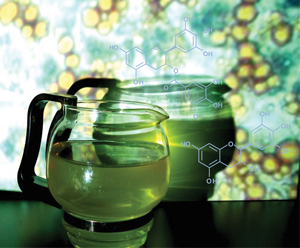New insights into the effect of green tea on the molecular mechanisms of glucose metabolism have recently been reported by Hitoshi Ashida and colleagues.
Tea is one of the world’s most popular beverages and due to its content of polyphenols, particularly catechins, it is considered to possess health promoting effects. Hitoshi Ashida and his team in Japan have previously showed that catechins in tea decrease glucose uptake in adipose tissue.
In adipose tissue, a membrane protein, GLUT4 is responsible for glucose uptake from the bloodstream. In the absence of insulin 95% of GLUT4 is located in the cell, but on insulin binding, GLUT4 is translocated to the surface and is able to transport glucose inside.
This current study published in Food & Function showed that gallate-type catechins reduce insulin-induced glucose uptake by reducing the translocation of GLUT4 to the outside of the cell. In contrast, the team discovered that in the absence of insulin, when GLUT4 is usually contained intracellularly, a different group of catechins, nongallate-type, increased glucose uptake by increasing the translocation of GLUT4 to the outside of the cell. An analysis of the signalling pathways involved showed that the gallate-type catechins inhibited the insulin-signalling pathway, but that the nongallate-type catechins were able to increase translocation of GLUT4 without utilising this pathway.
The team from Kobe University and the Central Research Institute have demonstrated that green tea catechins modulate glucose transport in adipose tissue, affecting blood glucose levels. In a world where the incidence of hypoglycaemia is increasing year by year, insights such as these are invaluable in identifying possible compounds which have the potential to regulate blood glucose levels.
Anna Simpson
Read more about this article:











